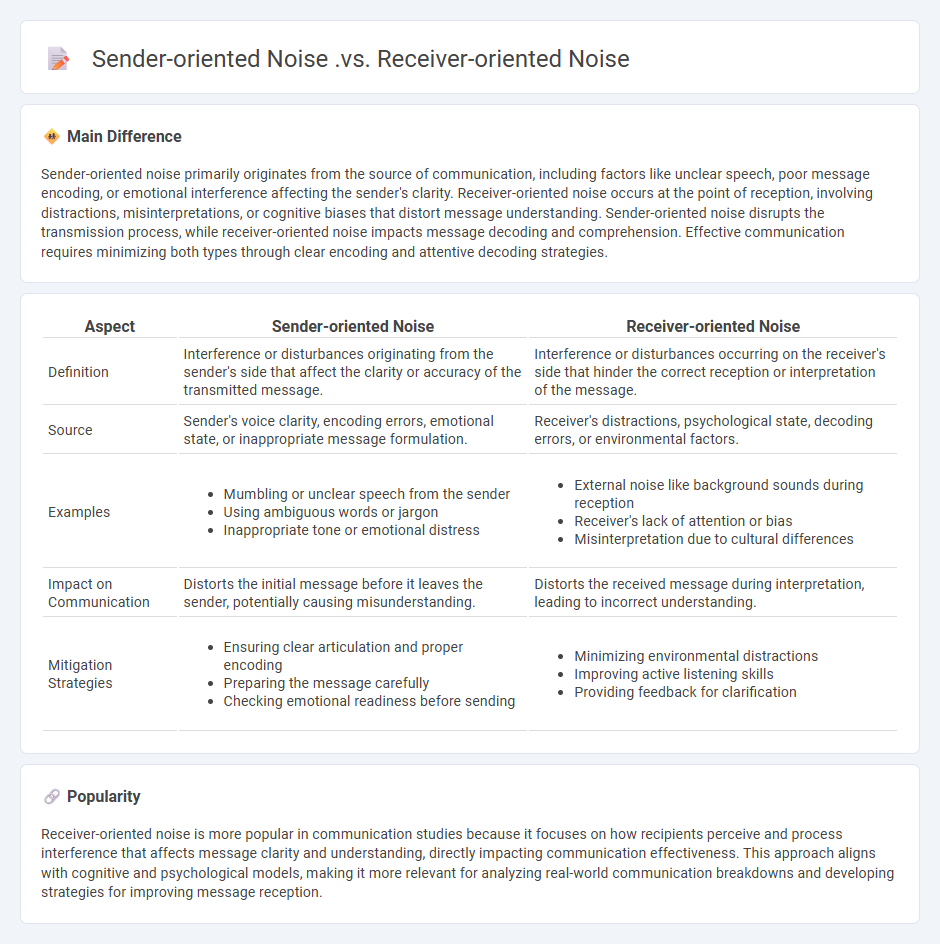
Sender-oriented noise refers to disruptions originating from the sender's side, such as unclear messaging or technical errors during transmission that distort the intended communication. Receiver-oriented noise involves interference at the receiving end, including distractions, misinterpretation, or sensory impairments that hinder message comprehension. Explore further to understand how these noise types impact communication effectiveness and strategies to mitigate them.
Main Difference
Sender-oriented noise primarily originates from the source of communication, including factors like unclear speech, poor message encoding, or emotional interference affecting the sender's clarity. Receiver-oriented noise occurs at the point of reception, involving distractions, misinterpretations, or cognitive biases that distort message understanding. Sender-oriented noise disrupts the transmission process, while receiver-oriented noise impacts message decoding and comprehension. Effective communication requires minimizing both types through clear encoding and attentive decoding strategies.
Connection
Sender-oriented noise refers to distortions originating from the sender's side, such as unclear messaging or inappropriate channel choice, impacting message clarity. Receiver-oriented noise involves distractions or misunderstandings experienced by the receiver, like environmental disruptions or cognitive biases, hindering message interpretation. Both types of noise interact by degrading the communication process, where sender-originated issues can amplify receiver challenges, resulting in overall message distortion and communication breakdown.
Comparison Table
| Aspect | Sender-oriented Noise | Receiver-oriented Noise |
|---|---|---|
| Definition | Interference or disturbances originating from the sender's side that affect the clarity or accuracy of the transmitted message. | Interference or disturbances occurring on the receiver's side that hinder the correct reception or interpretation of the message. |
| Source | Sender's voice clarity, encoding errors, emotional state, or inappropriate message formulation. | Receiver's distractions, psychological state, decoding errors, or environmental factors. |
| Examples |
|
|
| Impact on Communication | Distorts the initial message before it leaves the sender, potentially causing misunderstanding. | Distorts the received message during interpretation, leading to incorrect understanding. |
| Mitigation Strategies |
|
|
Message Encoding
Message encoding in communication involves transforming thoughts or information into symbols, such as words, images, or sounds, to convey a clear message to the receiver. Effective encoding requires understanding the audience's language, culture, and context to minimize misinterpretation. Common encoding methods include verbal, nonverbal, and digital formats, each tailored to different communication channels. Proper encoding enhances clarity and ensures that the intended message is accurately transmitted and decoded.
Transmission Clarity
Transmission clarity in communication refers to the accuracy and intelligibility with which a message is conveyed from the sender to the receiver. High transmission clarity minimizes distortion, noise, and ambiguity, ensuring the intended meaning is understood without error. Factors influencing transmission clarity include signal strength, communication channel quality, encoding methods, and receiver proficiency. Effective transmission clarity is crucial in fields such as telecommunications, broadcasting, and data networks to maintain message integrity and reduce retransmissions.
Perception Barriers
Perception barriers in communication occur when individuals interpret messages based on personal biases, experiences, or cultural backgrounds, leading to misunderstandings. These barriers include stereotyping, selective perception, and the halo effect, which distort the sender's intended meaning. Differences in language proficiency and emotional states further exacerbate perception challenges, reducing message clarity. Effective communication requires awareness of these barriers to enhance mutual understanding and message accuracy.
Sender Responsibility
Sender responsibility in communication involves ensuring clarity, accuracy, and appropriateness of the message conveyed to the receiver. Effective senders anticipate potential misunderstandings and tailor their language, tone, and content to the audience's needs and context. This responsibility also includes verifying information before transmission to maintain credibility and foster trust. Research by the International Communication Association highlights that sender clarity significantly reduces miscommunication and enhances message retention.
Receiver Interpretation
Receiver interpretation is a critical process in communication where the receiver decodes and makes sense of the transmitted message based on their own experiences, knowledge, and cultural background. Effective communication depends on the receiver accurately interpreting the sender's intended meaning to avoid misunderstandings or miscommunication. Factors such as language barriers, context, tone, and non-verbal cues significantly influence how the receiver constructs meaning from the message. Cognitive biases and emotional states can also alter the receiver's interpretation, affecting the overall communication outcome.
Source and External Links
Defining Communication - This webpage discusses noise in communication, which includes both external and internal factors affecting the sender and receiver but doesn't explicitly categorize them as sender- or receiver-oriented.
Sender & Receiver Oriented Communication Barriers - This page explains communication barriers but does not specifically address sender-oriented versus receiver-oriented noise; however, it touches on general barriers that could be related to both.
The 4 Types of Noise in Communication - This webpage describes different types of noise in communication, including psychological noise, but does not explicitly differentiate between sender-oriented and receiver-oriented noise.
FAQs
What is sender-oriented noise?
Sender-oriented noise refers to interference or distortions during communication that originate from the sender's side, such as unclear messaging, poor articulation, or transmission errors caused by the sender.
What is receiver-oriented noise?
Receiver-oriented noise refers to unwanted electrical signals or interference that originate within or near the receiver system, affecting its ability to accurately detect or process the desired incoming signal.
How does sender-oriented noise impact communication?
Sender-oriented noise distorts or interferes with the message during transmission, leading to misinterpretation, decreased clarity, and ineffective communication.
How does receiver-oriented noise affect message understanding?
Receiver-oriented noise distorts or blocks the message reception, leading to misunderstanding or misinterpretation by the receiver.
What are common sources of sender-oriented noise?
Common sources of sender-oriented noise include poor articulation, language barriers, physical distractions, technical issues with communication devices, and emotional disturbances affecting the sender.
What are examples of receiver-oriented noise?
Examples of receiver-oriented noise include thermal noise, shot noise, flicker noise, and intermodulation noise.
How can sender and receiver-oriented noise be minimized?
Sender-oriented noise can be minimized by improving message clarity, using simple language, and verifying message encoding correctness. Receiver-oriented noise is reduced by active listening, providing feedback, and minimizing distractions to enhance message decoding accuracy.
 calledges.com
calledges.com